Building a Winning Customer Retention Strategy in WooCommerce
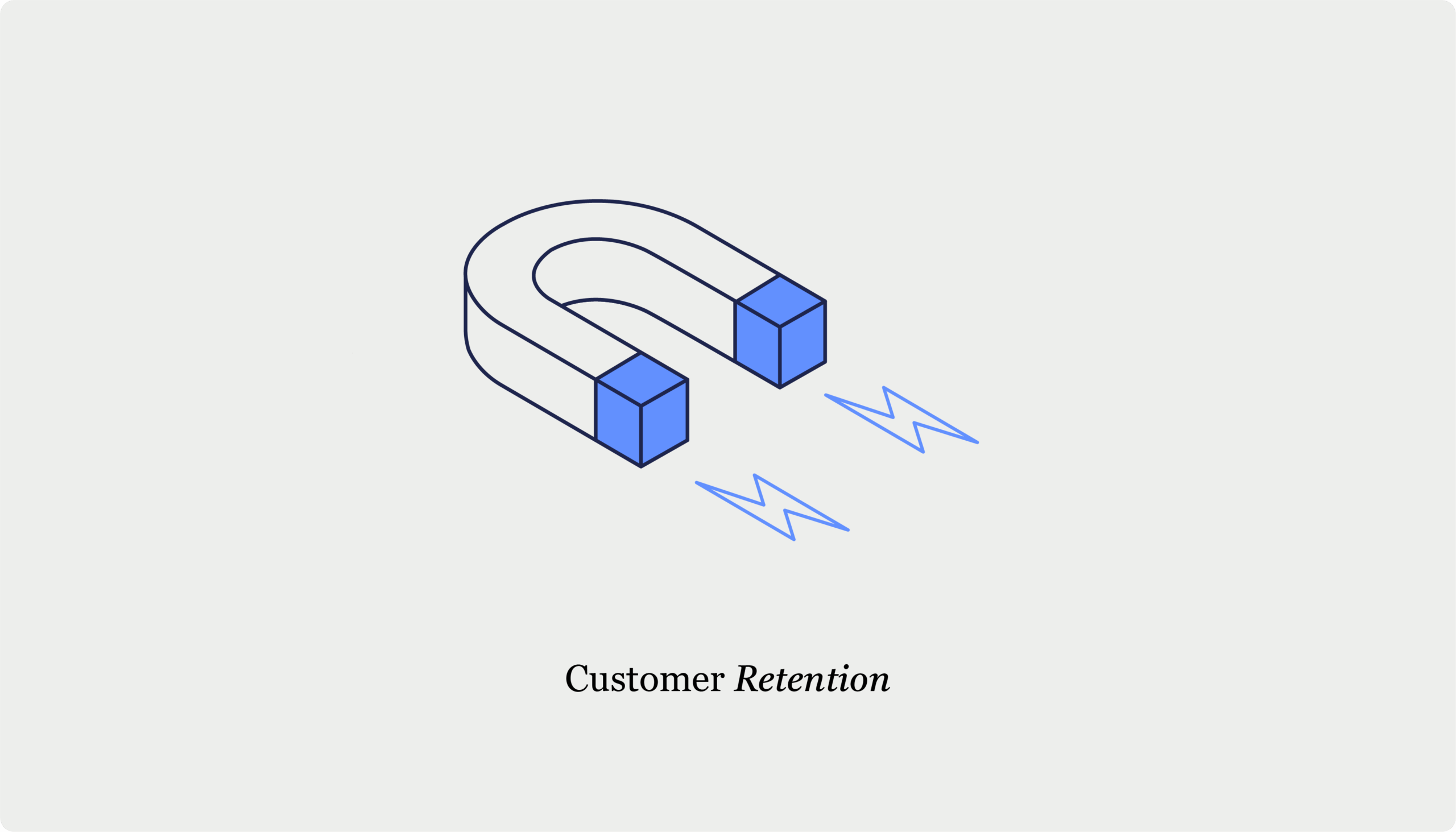
Table of Contents
- 7 proven strategies to increase WooCommerce customer retention
- 1. Build an effective loyalty program that drives repeat purchases
- Plugin options worth checking out
- 2. Provide excellent customer support to build trust
- Plugin recommendations worth your attention
- 3. Personalize the customer experience for a unique shopping experience
- 4. Create automated retention systems that work while you sleep
- 5. Design targeted email campaigns for customer engagement
- 6. Optimize the checkout flow for a better shopping experience
- How CheckoutWC transforms your WooCommerce checkout
- 7. Measure and improve your retention strategy
- Take your WooCommerce retention strategy to the next level
If you run a store, or any business, really, chances are you’ve heard of the term customer retention. Sounds fancy, but it’s actually quite simple – getting people to come back after they buy something from you. And if you want to build something that lasts, retention is one of the few things that actually matter.
The numbers don’t lie: CMSWire reports that customers who make a purchase at your store have a 27% chance of coming back for more. The reality, however, is that many WooCommerce store owners struggle with retention due to several common challenges:
- Complex checkout processes that drive customers away.
- Limited built-in retention tools in the standard WooCommerce.
- Customer data scattered across multiple plugins.
- Technical hurdles when setting up loyalty programs.
However, if you’re able to overcome these hurdles, you can create a smart retention strategy that delivers:
- Measurable ROI improvements.
- A significant edge over competing WooCommerce stores.
- Long-term growth through consistent repeat business.
- A deeper understanding of customer behaviors and preferences.
If any of that sounds useful, keep reading! We’ll skip the generic fluff and get straight to retention strategies that actually work for your WooCommerce store.
7 proven strategies to increase WooCommerce customer retention
1. Build an effective loyalty program that drives repeat purchases
Let’s face it – acquiring new customers usually costs a lot more than retaining existing ones, so a loyalty program is something that makes a lot of sense. Done well, it has the power to transform one-time buyers into brand advocates while significantly boosting your bottom line.
Think of loyalty programs as your store’s frequent flyer miles – the more customers interact with you, the more valuable their experience becomes.
So, what should you include?
- Clear earning rules: Make it obvious how customers earn points through purchases, referrals, social sharing, or product reviews.
- Simple redemption process: Don’t make customers solve puzzles to use their rewards – one-click redemption keeps them coming back.
- Tiered benefits: Create bronze/silver/gold systems where benefits increase with customer engagement (because everyone wants to level up).
- Balanced reward mix: Combine discounts with exclusive perks like early access or special content.
- Strategic urgency: Use time-limited offers and expiration dates to drive action without creating anxiety.
There are many different ways to construct a loyalty program, but there’s no universally best reward structure – only the best possible option for your unique situation.
Here are some examples:
| Rewards structure | Description | Best for |
| Points-based | Customers earn points for every dollar spent, which can be redeemed for discounts, products, or perks. | General retail stores with frequent, moderate-value purchases. |
| Cashback | Customers receive store credit based on purchase amounts, typically as a percentage of spend. | Businesses with healthy profit margins that can afford to give back a percentage of sales. |
| Tiered VIP | Progressive levels (bronze, silver, gold) with increasingly valuable benefits as customers reach spending thresholds. | Premium or luxury brands where exclusivity drives customer motivation. |
| Subscription | Paid membership model offering ongoing benefits like free shipping, exclusive access, or discounts. | Stores with predictable inventory cycles and customers who purchase regularly. |
| Shipping/Discount focus | Simple structure focusing on free shipping thresholds or percentage discounts based on purchase frequency. | Entry-level programs or businesses targeting price-sensitive customers. |
🤔Make your program dead simple to understand. If customers need a calculator and a legal degree to figure out their rewards, you’ve already lost them.
Plugin options worth checking out
- For exclusive content access: Constellation ($249/year) creates members-only areas for premium products or content.
- For points-based rewards: Points and Rewards for WooCommerce (Free version available, paid from $99/year).
- For subscription models: Subscriptions for WooCommerce ($279/year) or just use Constellation again.
- For advanced discounts: WooCommerce Smart Coupons ($129/year) for gift cards, BOGO deals, and store credits.
The most successful loyalty programs reward relationships, not just transactions. That means acknowledging birthdays, celebrating anniversaries, and recognizing milestones in ways that make customers feel valued, not just monetized.
2. Provide excellent customer support to build trust
Customer support is your brand’s heartbeat. A Gartner study shows that 80% of companies compete primarily on customer experience, meaning exceptional support has the power to transform casual shoppers into brand advocates who return again and again.
Here’s what can help you stand out:
- Embrace multi-channel support: Meet customers where they prefer – whether that’s live chat while browsing, email for detailed questions, or social media for quick updates. Each channel serves different needs at different stages of the customer journey (and different levels of social anxiety for that matter).
- Prioritize response speed: The modern shopper expects answers in minutes, not days. Aim for under 1 hour for emails and instant responses for live chat. You can also set up automated acknowledgments to let customers know you’ve received their questions and when to expect a full response.
- Deploy AI strategically: Use chatbots to handle routine inquiries like order tracking and product availability, freeing your human team to tackle complex issues that require empathy and problem-solving skills.
- Create a comprehensive knowledge base: Self-service resources are cost-effective and the preferred answer searching method for many customers. To help them out, build an easily searchable FAQ section with clear categories and visual guides.
- Make support personal: Address customers by name, reference their purchase history, and tailor solutions to their specific situation. The difference between “We can help with that order” and “I see your Batman coffee mug shipped yesterday, John” is enormous.
- Close the loop: Follow up after resolving issues to ensure satisfaction. A simple “How did we do?” email demonstrates that you care about the outcome, not just closing tickets.
- Simplify returns and refunds: A clear, no-hassle return policy reduces purchase anxiety and builds trust. Make your policy prominent and easy to understand – no legal jargon or hidden conditions.
Plugin recommendations worth your attention
- Tidio: Combines live chat with AI chatbots for 24/7 coverage (From $29/month)
- ChatBot for WooCommerce: Specializes in ecommerce-specific support automation ($49/year)
Remember: Every support interaction is a retention opportunity. The customer who has a problem solved quickly and cheerfully becomes twice as loyal as one who never had a problem at all.
3. Personalize the customer experience for a unique shopping experience
Generic shopping experiences no longer cut it in today’s competitive ecommerce environment. Research shows that 80% of shoppers are more likely to purchase from brands offering personalized experiences, and 91% prefer shopping with businesses that provide relevant recommendations.
Simply put, personalization transforms anonymous visitors into recognized, valued customers by leveraging their unique data footprint to create tailored interactions at every touchpoint.
Here’s how you can implement that in your business:
- Smart product recommendations: Implement AI-powered suggestion engines that analyze purchase history, browsing patterns, and wish lists to present products customers actually want, not just what you’re trying to sell.
- Targeted email campaigns: Segment your audience based on purchase behavior, engagement level, and preferences to deliver highly relevant content rather than one-size-fits-all blasts that end up in the trash folder.
- Dynamic pricing structures: Reward loyal customers with special pricing tiers, exclusive bundle offers, or early-access discounts that acknowledge their ongoing relationship with your brand.
- Behavior-triggered marketing: Create automated workflows that respond to specific customer actions with relevant content – abandoned cart reminders, birthday offers, or replenishment suggestions for consumable products.
- Customized shopping journeys: Enable features like saved favorites, back-in-stock notifications, and personalized landing pages that make navigation intuitive and relevant.
- Post-purchase personalization: Follow up with tailored thank-you messages, product care guides specific to purchased items, and complementary product suggestions that enhance their recent purchase.
Plugin solutions worth implementing:
- CheckoutWC: Add targeted order bumps based on cart contents and purchase history ($19/month)
- AutomateWoo: Create sophisticated, personalized marketing workflows based on customer actions ($159/year)
- MonsterInsights: Gather the deep analytics needed to inform your personalization strategy ($99.60/year)
The most effective personalization doesn’t feel intrusive – it feels helpful. Strike the right balance between using customer data and respecting privacy to build trust alongside relevance.
4. Create automated retention systems that work while you sleep
Setting up automated retention systems is like hiring a tireless sales team that works 24/7 without complaints, coffee breaks, or commission. These systems deliver the right message to the right customer at precisely the right moment – whether that’s 3 PM or 3 AM.
The beauty of automation lies in its consistency and scalability. Once properly configured, these systems maintain perfect timing and personalization across your entire customer base, something impossible to achieve manually.
Automated retention strategies that deliver results:
- Abandoned cart recovery: Implement triggered emails that remind customers about items left in their cart, ideally with a small incentive to complete the purchase. CheckoutWC offers versatile cart recovery tools that, when properly implemented, can help recapture abandoned sales.
- Post-purchase sequence: Create a series of automated emails that thank customers, provide tracking information, share usage tips, and suggest complementary products – all timed to match the customer journey stages.
- Loyalty milestone notifications: Set up automatic alerts when customers earn rewards or reach new loyalty tiers, encouraging immediate engagement and redemption.
- Subscription management: Implement systems that handle recurring orders, payment processing, and renewal reminders, reducing customer effort while securing repeat revenue.
- Replenishment prompts: For consumable products, calculate average usage time and trigger reminders just before customers run out, solving a problem before they even realize they have one.
The most effective automated systems feel personal despite being programmed. They anticipate customer needs, remove friction points, and create the impression that your store is always attentive to individual shoppers, even when you’re fast asleep.
5. Design targeted email campaigns for customer engagement
Email remains the highest ROI marketing channel available, delivering $36 for every $1 spent when done right. The key difference between emails that convert and those that irritate lies in precise targeting and genuine value.
Successful retention email campaigns are systematically organized, data-driven, and designed to meet customers at their specific point in the relationship with your store.
Types of retention emails that drive results:
- Personalized recommendations: Send product suggestions based on purchase history, browsing behavior, and similar customer profiles, not just generic bestsellers.
- VIP-exclusive offers: Create special promotions only available to your best customers, giving them early access to new products, special pricing, or limited-edition items.
- Strategic win-back campaigns: Re-engage dormant customers with compelling reasons to return, such as “We miss you” messages paired with meaningful incentives tailored to their previous buying patterns.
- Enriched post-purchase communications: Follow up with content that enhances the value of their purchase – usage guides, maintenance tips, styling ideas, or complementary product suggestions.
- Review request sequences: Timing is crucial here – send these when customers have had enough time to experience your product, and offer a small incentive for honest feedback.
- New releases and seasonal promotions: Target these based on previous purchase categories and browsing history rather than blasting your entire list.
Best practices for maximum impact:
- Use dynamic content blocks that automatically adapt based on customer segments and behaviors.
- Include personalized product recommendations that reflect actual interests, not just what you want to promote.
Email platform recommendations:
- Mailchimp: Solid entry-level option with user-friendly templates and basic automation (Free for under 600 emails/month, from $20/month for more)
- Klaviyo: Specialized ecommerce email platform with advanced segmentation and predictive analytics (Free under 500 emails/month, from $45/month)
6. Optimize the checkout flow for a better shopping experience
Your checkout process is the final hurdle between browsing and buying – and unfortunately, it’s where 70% of potential sales crash and burn. Thankfully, most of those lost opportunities can be easily prevented through the magic of friendsh– we mean, checkout optimization.
The math is simple: A streamlined checkout process directly impacts your bottom line by:
- Reducing cart abandonment rates (currently averaging 69.8% across ecommerce).
- Increasing conversion rates by up to 35.6% with best practices.
- Building customer confidence that leads to higher average order values.
- Creating positive experiences that customers associate with your brand.
Here’s what you need to do to transform hesitant browsers into confident buyers and first-time customers into repeat purchasers.
- Streamline the flow: Remove every unnecessary field, click, and step between “Add to Cart” and “Order Complete.”
- Expand payment options: Customers expect choices beyond credit cards. Offering PayPal increases conversions by 30% on average, while Apple Pay and Google Pay can boost mobile conversions significantly.
- Perfect the mobile experience: With over 68% of ecommerce sales happening on mobile devices, your checkout must be thumb-friendly, with large buttons, minimal typing, and responsive design.
- Eliminate distractions: During checkout, remove navigation menus, sidebar widgets, and anything else that might pull customers away from completing their purchase.
How CheckoutWC transforms your WooCommerce checkout
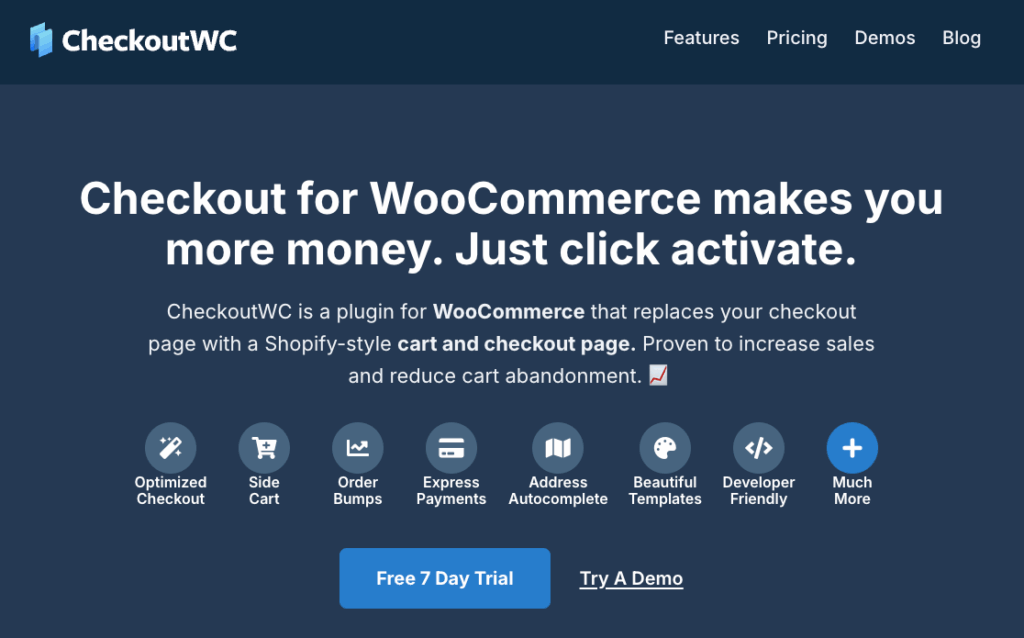
CheckoutWC was designed specifically to solve these conversion-killing checkout problems with features like:
- Customizable checkout templates that match your brand while optimizing for conversions.
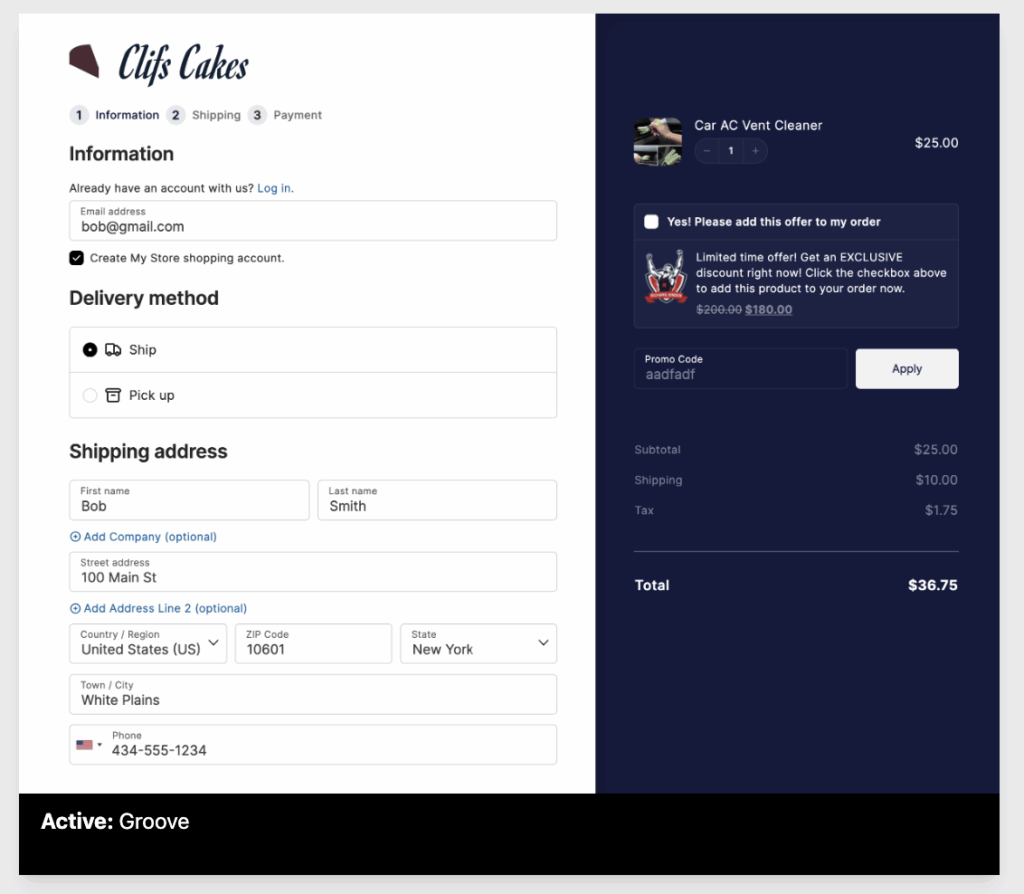
- Floating side cart that gives shoppers instant visibility into their selections without leaving their shopping experience.
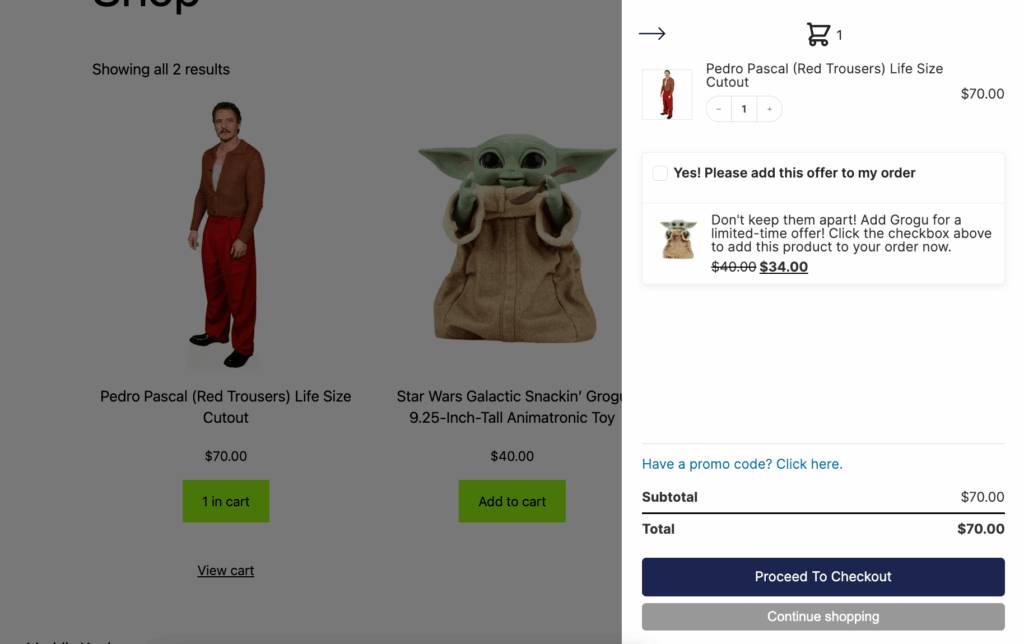
- Field optimization that intelligently reduces unnecessary form fields based on customer selections.
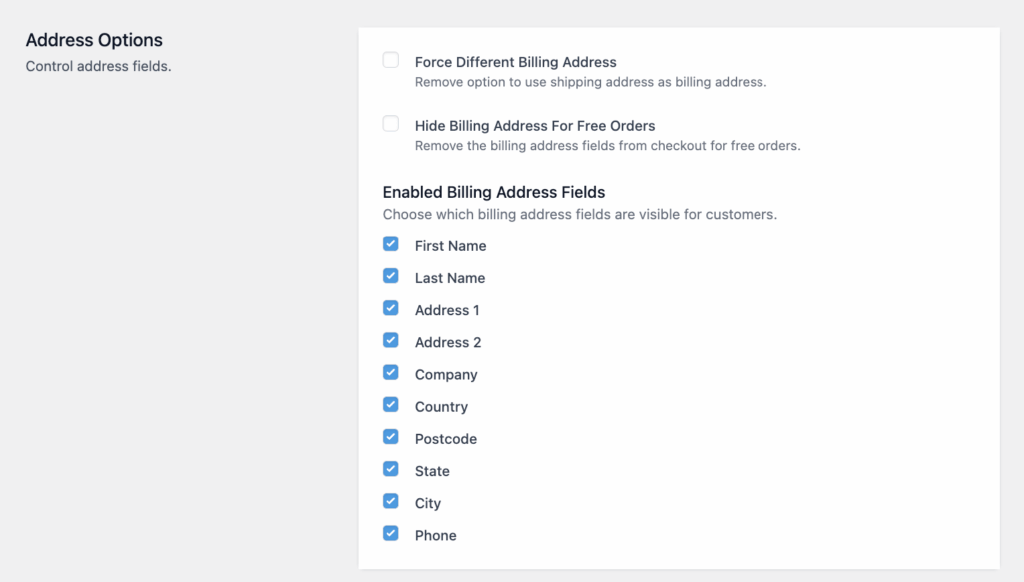
- Flexible checkout options, including one-page checkout for simplicity or multi-step checkout with progress indicators and order reviews for complex orders.
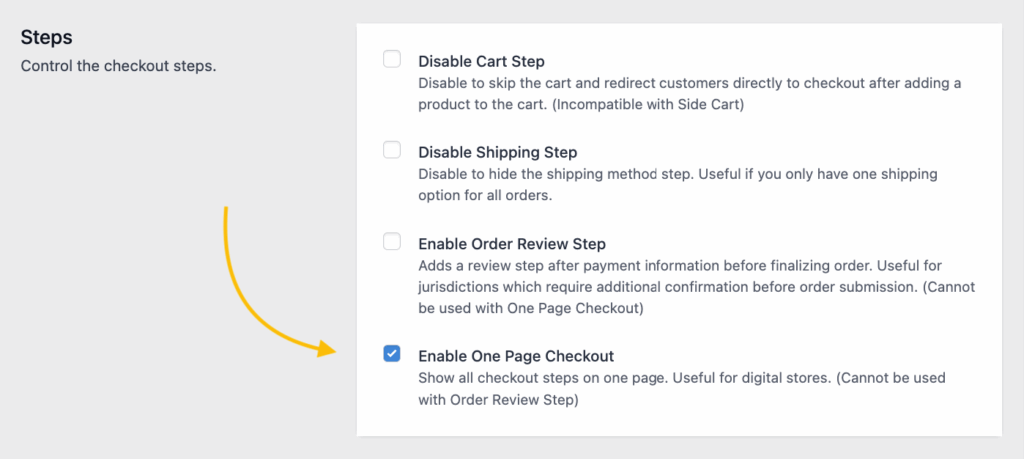
- Express payment integration with Apple Pay, Google Pay, and PayPal for one-click purchasing.
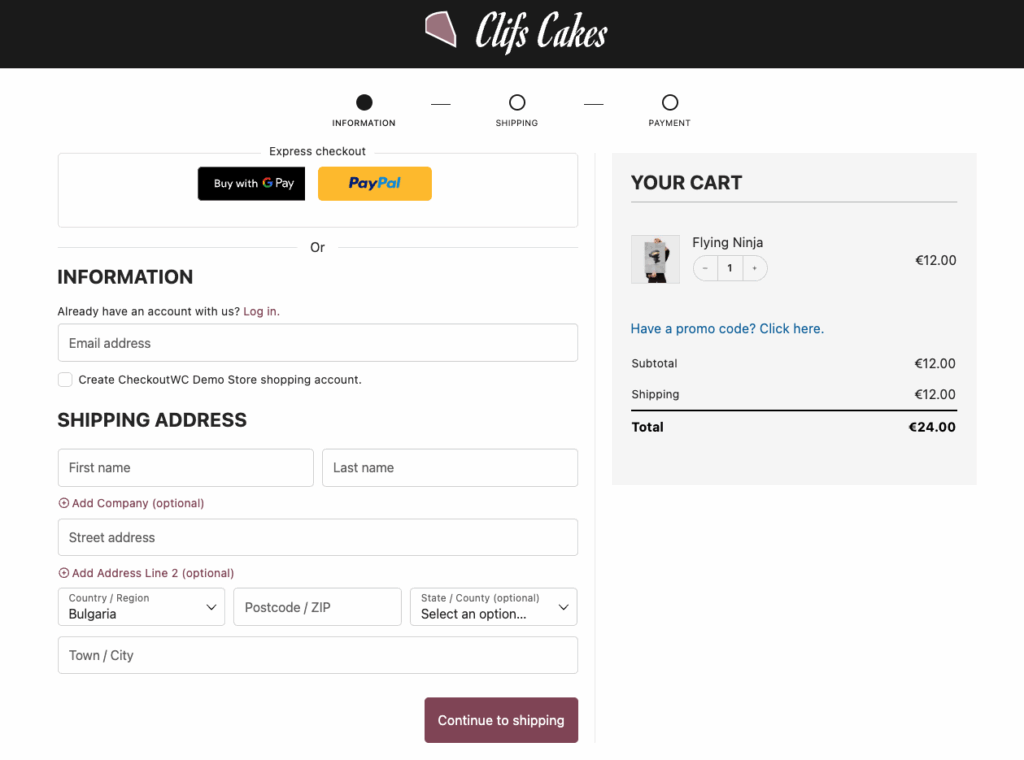
- Address autocomplete functionality that reduces typing errors and speeds up the checkout process by up to 40%.

- Trust badges that visually reassure customers about payment security and return policies.
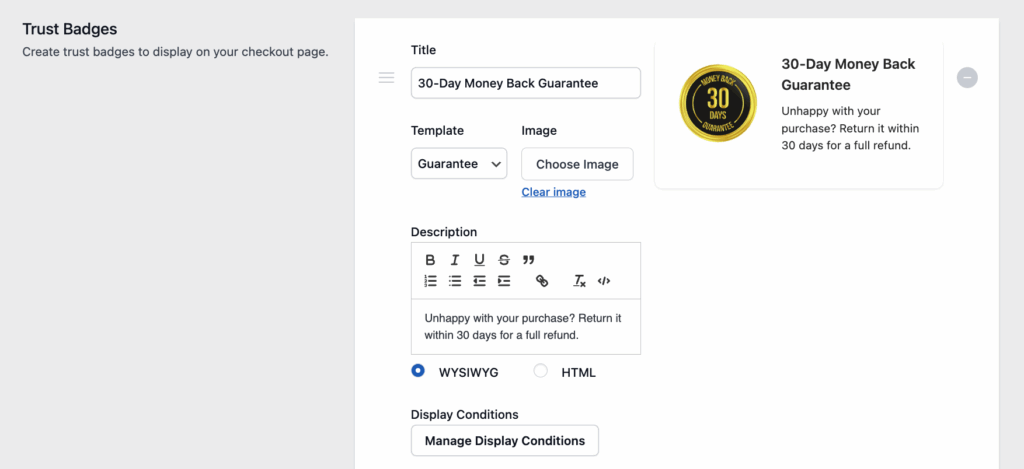
The best checkout experiences feel invisible – customers barely notice they’ve completed a purchase because the process was so intuitive and frictionless. With CheckoutWC, you transform a standard WooCommerce checkout into a conversion machine that customers actually enjoy using.
7. Measure and improve your retention strategy
Without measurement, you’re flying blind. Tracking the right metrics transforms your retention efforts from guesswork into a data-driven strategy that delivers measurable ROI. The most successful WooCommerce stores monitor retention metrics with the same intensity as they track acquisition.
Essential retention KPIs every store should monitor:
- Customer retention rate (CRR): This core metric shows the percentage of customers who return to make additional purchases within a specific timeframe. Calculate it by dividing the number of customers at the end of a period (minus new customers acquired) by the number at the start.
- Customer lifetime value (CLV): Perhaps the most powerful metric in your arsenal, CLV estimates the total revenue a customer will generate throughout their relationship with your store. Rising CLV indicates your retention strategies are working.
- Repeat purchase rate: This straightforward percentage shows how many customers make more than one purchase. Low rates indicate customers aren’t finding enough value to return.
- Cart abandonment rate: While technically a conversion metric, high abandonment rates often signal trust or experience issues that impact long-term retention.
“The most effective retention strategy is one that evolves continuously based on customer data. Successful merchants test variations, analyze performance patterns, and refine approaches based on what actually resonates with their specific audience. This iterative process separates thriving stores from struggling ones.”
Ian Misner, General Manager at Kestrel
Analytics tools worth implementing:
- Google Analytics: The foundation for all measurement, with powerful custom reporting capabilities for tracking retention cohorts.
- Metorik: Custom reports and email marketing tools built specially for WooCommerce and Shopify.
- Metrilo: Purpose-built for ecommerce with retention-focused analytics, CRM integration, and detailed customer journey mapping.
- RFM Segmentation for WooCommerce: Automatically categorizes customers by recency, frequency, and monetary value – pinpointing exactly where to focus retention efforts.
The most sophisticated retention strategies use metrics to create a feedback loop: Measure, analyze, adjust, and repeat. This continuous improvement approach ensures that your retention tactics stay relevant as customer preferences evolve.
Take your WooCommerce retention strategy to the next level
Customer retention is the backbone of sustainable ecommerce growth. Implementing these proven strategies creates a virtuous cycle where happy customers return, spend more, and bring others along.
Focus on these critical elements to maximize retention:
- Create frictionless user experiences at every touchpoint.
- Maintain purposeful, value-driven communication.
- Act quickly on customer feedback (positive and negative).
- Deploy targeted re-engagement campaigns for dormant customers.
- Build exclusivity and urgency into promotions.
- Foster a genuine community around your brand values.
CheckoutWC transforms standard WooCommerce stores into retention powerhouses with features like streamlined checkout flows, intuitive cart recovery, and conversion-optimized templates. By reducing friction at the most critical moment in the customer journey, CheckoutWC addresses a primary pain point in customer retention.
Ready to transform browsers into buyers and first-time customers into lifelong fans? Start implementing these retention strategies today with CheckoutWC’s powerful toolkit.
The simplicity of Shopify with the power of WooCommerce. Replace your WooCommerce checkout page with CheckoutWC to boost sales and reduce cart abandonment.